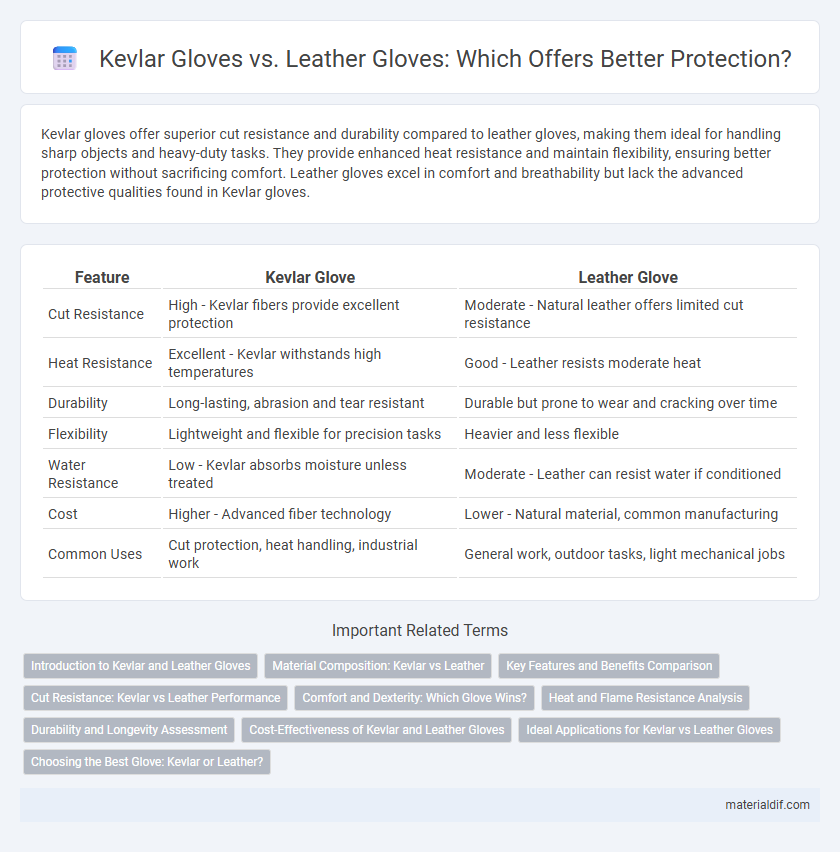Kevlar gloves offer superior cut resistance and durability compared to leather gloves, making them ideal for handling sharp objects and heavy-duty tasks. They provide enhanced heat resistance and maintain flexibility, ensuring better protection without sacrificing comfort. Leather gloves excel in comfort and breathability but lack the advanced protective qualities found in Kevlar gloves.
Table of Comparison
| Feature | Kevlar Glove | Leather Glove |
|---|---|---|
| Cut Resistance | High - Kevlar fibers provide excellent protection | Moderate - Natural leather offers limited cut resistance |
| Heat Resistance | Excellent - Kevlar withstands high temperatures | Good - Leather resists moderate heat |
| Durability | Long-lasting, abrasion and tear resistant | Durable but prone to wear and cracking over time |
| Flexibility | Lightweight and flexible for precision tasks | Heavier and less flexible |
| Water Resistance | Low - Kevlar absorbs moisture unless treated | Moderate - Leather can resist water if conditioned |
| Cost | Higher - Advanced fiber technology | Lower - Natural material, common manufacturing |
| Common Uses | Cut protection, heat handling, industrial work | General work, outdoor tasks, light mechanical jobs |
Introduction to Kevlar and Leather Gloves
Kevlar gloves, made from a high-strength synthetic fiber developed by DuPont, offer exceptional cut resistance and heat protection, making them ideal for industrial and safety applications. Leather gloves, crafted from animal hides such as cowhide or goatskin, provide durability, flexibility, and abrasion resistance but generally lack the advanced protective qualities of Kevlar. Comparing Kevlar and leather gloves highlights the superior protective performance of Kevlar in hazardous environments, while leather gloves remain favored for general handling and comfort.
Material Composition: Kevlar vs Leather
Kevlar gloves are made from para-aramid synthetic fibers known for their high tensile strength and excellent cut, heat, and abrasion resistance. Leather gloves are crafted from animal hides, primarily cowhide, which provides durability and natural flexibility but offers less resistance to cuts and heat compared to Kevlar. The molecular structure of Kevlar fibers enables superior protection in industrial and safety applications, while leather remains favored for comfort and dexterity in general use.
Key Features and Benefits Comparison
Kevlar gloves provide superior cut resistance and heat protection compared to leather gloves, making them ideal for high-risk industrial tasks and firefighting. They are lightweight, flexible, and offer enhanced dexterity, ensuring better grip and reduced hand fatigue during extended use. Leather gloves excel in abrasion resistance and durability but lack the advanced protective properties and heat resistance that Kevlar fibers deliver.
Cut Resistance: Kevlar vs Leather Performance
Kevlar gloves offer superior cut resistance compared to leather gloves due to their aramid fiber composition, which provides high tensile strength and durability against sharp objects. Leather gloves, while durable and flexible, lack the advanced cut-resistant properties found in Kevlar, making them less effective in preventing lacerations. For industries requiring high safety standards, Kevlar gloves significantly reduce the risk of cut injuries, outperforming leather gloves in cut resistance performance.
Comfort and Dexterity: Which Glove Wins?
Kevlar gloves offer superior comfort and dexterity compared to leather gloves due to their lightweight, flexible construction and breathability, which reduce hand fatigue during prolonged use. The high tensile strength fibers in Kevlar allow for snug fitting gloves that enhance grip precision and fine motor control without compromising protection. Leather gloves, while durable, often feel stiffer and heavier, limiting finger movement and overall comfort in intricate tasks.
Heat and Flame Resistance Analysis
Kevlar gloves provide superior heat and flame resistance compared to leather gloves, withstanding temperatures up to 800degF (427degC) without melting or degrading. Unlike leather, which can char and burn when exposed to high heat, Kevlar maintains structural integrity and offers enhanced protection against thermal hazards. This makes Kevlar gloves ideal for applications in firefighting, welding, and industrial environments requiring reliable heat and flame resistance.
Durability and Longevity Assessment
Kevlar gloves offer superior durability compared to leather gloves due to their high tensile strength and resistance to abrasion, cuts, and heat. The synthetic aramid fibers in Kevlar maintain integrity under extreme conditions, resulting in extended longevity for repeated heavy-duty use. Leather gloves, while flexible and comfortable, tend to degrade faster when exposed to moisture, chemicals, and constant wear, limiting their overall lifespan.
Cost-Effectiveness of Kevlar and Leather Gloves
Kevlar gloves offer superior cut resistance and durability, extending their lifespan and reducing replacement frequency compared to traditional leather gloves. Although the initial cost of Kevlar gloves is higher, their enhanced protection and longer usability provide better overall cost-effectiveness in high-risk environments. Leather gloves tend to be less expensive upfront but wear out faster, leading to more frequent purchases and potentially higher long-term costs.
Ideal Applications for Kevlar vs Leather Gloves
Kevlar gloves excel in high-performance environments requiring cut resistance, heat protection, and durability, making them ideal for industries such as construction, manufacturing, and firefighting. Leather gloves provide superior comfort, flexibility, and abrasion resistance, suitable for tasks like gardening, welding, and general labor where dexterity is crucial. Choosing between Kevlar and leather gloves depends on the balance between protection level and tactile sensitivity needed for specific applications.
Choosing the Best Glove: Kevlar or Leather?
Kevlar gloves offer superior cut resistance and heat protection compared to leather gloves, making them ideal for industrial and hazardous work environments. Leather gloves provide better flexibility and comfort for general tasks but lack the high durability and strength of Kevlar. Selecting the best glove depends on the specific safety requirements, with Kevlar excelling in protection against sharp objects and leather preferred for lighter, everyday use.
Kevlar glove vs Leather glove Infographic

 materialdif.com
materialdif.com